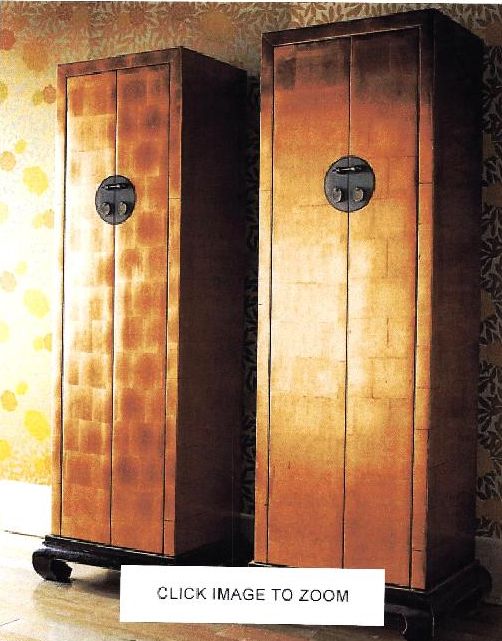Application Tips for Gold Leaf
Gold leaf gilding methods explained. December 9, 2010
Question
Does anyone know how they laid up the gold leaf on these cabinets?

Click here for higher quality, full size image
Forum Responses
(Finishing Forum)
From contributor G:
It does not look burnished (high metallic sheen), therefore it is most likely not water gilding, which requires a complicated base preparation with gesso and sizing/gilding clay (bole) as well as burnishing. It appears to be oil gilding, which just requires a smooth surface, an optional coat of red or yellow to make gaps in the gold less visible and to improve the depth of color of the gold, and a (not optional) coat of oil size. The oil size comes in 3 and 12 hour type. The 3 hour takes about 3 hours to dry and then remains tacky enough to apply the leaf for 3 hours. Same deal, 12 and 12, for the 12 hour. Top coating is optional also. Lots of suppliers of leaf and size online, and several sites with gilding instructions.
From the original questioner:
How do you achieve the brick look? Does the substrate need to be carved out for the particular pattern? And could this be coated with, say, MagnaMax lacquer without to much effort?
From contributor C:
I can't tell from the picture, but that running bond brick look is probably just the seams of the leaf. Lay out the desired pattern with a pencil. I have had problems using pre-cats such as Magnamax and have been using ML Campbell's MagnaKlear acrylic lacquer. Someone wrote in another thread that synthetic topcoats over organic sizing are never a good idea, which is true. You should never topcoat a reversible finish with a catalyzed finish, even pre-cat.
From contributor S:
The brick look will be easier to achieve using patent gold leaf than loose leaf. The borders are just the background (whatever background you have chosen) allowed to show by not overlapping your leaf and instead leaving a small gap.
From contributor G:
Contributor S, I think you are right. It's also possibile that it was done with schlag metal, using a block that has edge tarnished naturally or has been treated to color the edges. Can't get any sense of scale to tell if we are looking at 3 1/4 inch or 6 inch leaf.
I'm also wondering if it is a manufactured wallpaper (I have seen such), or if it was done with metallic wallpaper squares (like old tea chest paper work, a kind of decoupage). I think any of those could get that look, but the best job would be carat leaf laid with a bit of gap as you suggest.
From contributor W:
Yes, it is gold leaf. The brick pattern comes from the gold leaf when it is laid on the surface. But doing a gild finish on a big cabinet is quite difficult. You need skilled people to do the glue and leaf layering. It is a long process and requires a special room to prevent dust and weather problems.
